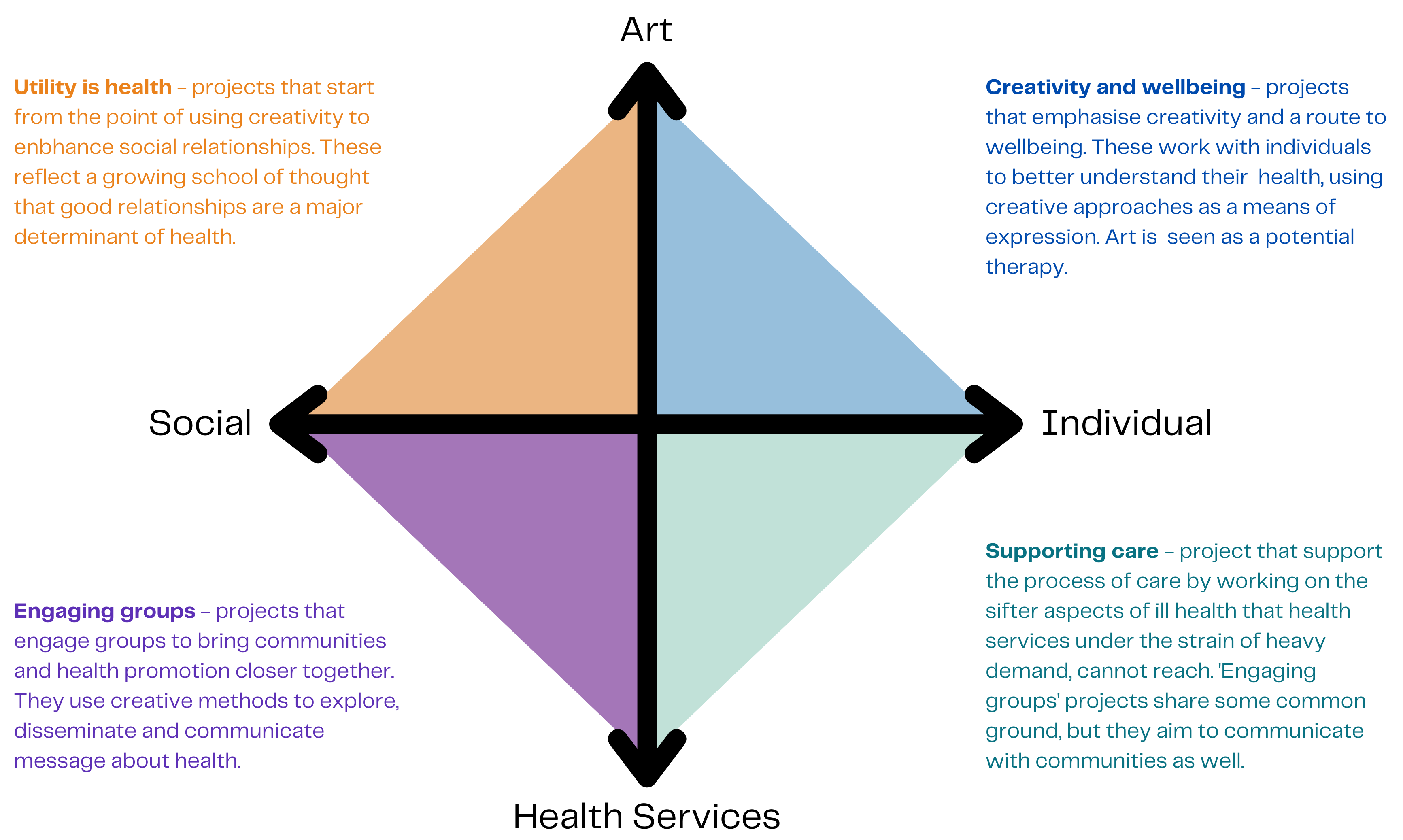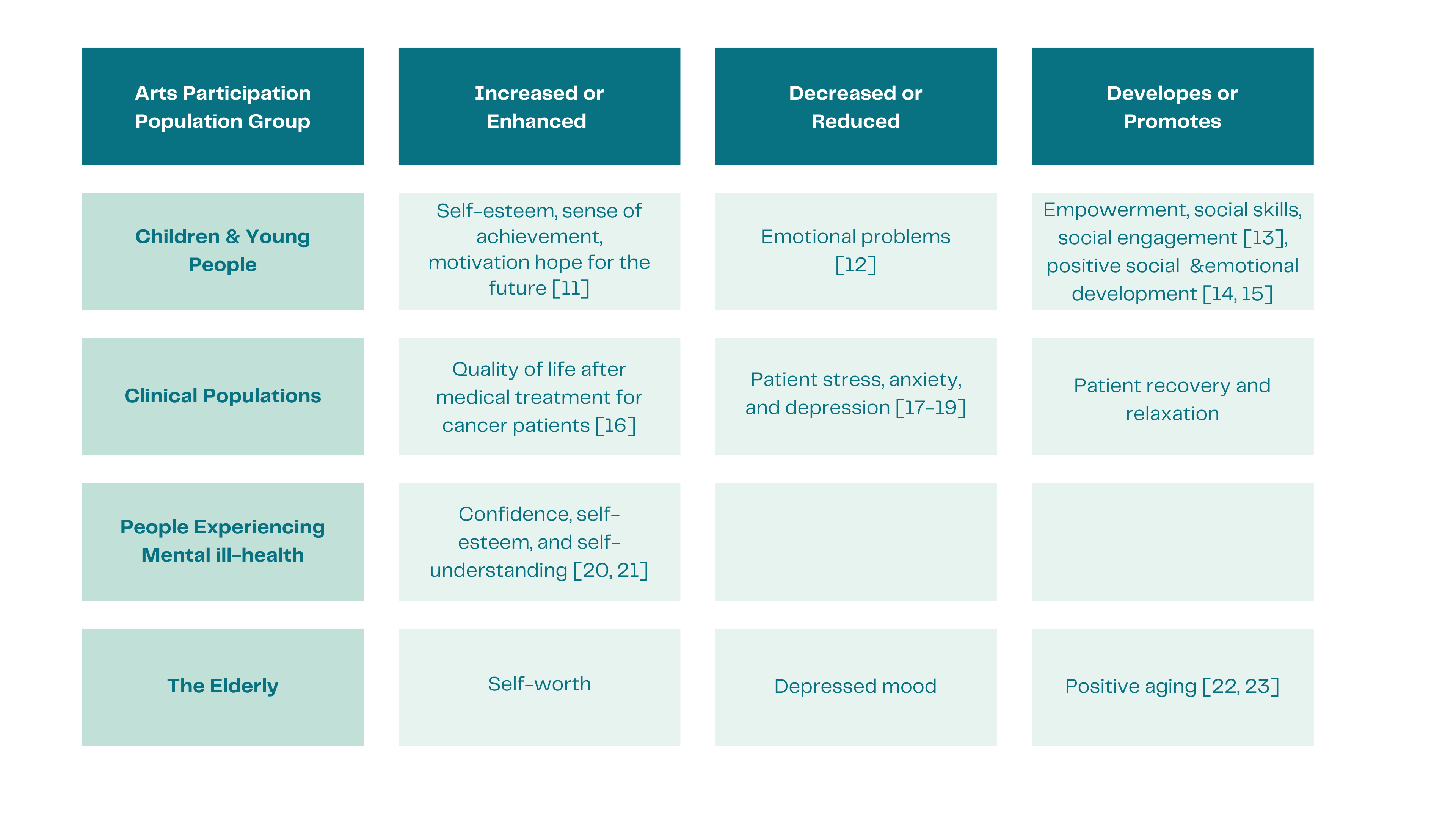To explore this, we first need to look at the different ways the arts and health interact – that is, the various programs and projects implemented.

Models of health and the arts
The Art and Health Diamond Model [23] explains how the arts can focus in different ways on health. The horizontal axis moves from focusing on the individual to the social effects. The vertical axis moves from focusing on health services to the art form itself. According to this model, projects can situate themselves within the four points, moving from art to health, and social to individual. However, for a project to become embedded within health services, it moves towards the ‘health’ end of the spectrum, having less of the arts involved as it moves away from the ‘arts’ end of the spectrum. This may imply that rather than sitting alongside one another, the arts and health sit as opposites. This is not necessarily the case.

Ansdell’s Continua Model [24] looks at the aims of the activity (using music as an example) and proposes that different projects are situated along two continua:
- Individual effects to the social effects (like the Arts and Health Diamond).
- The mind the body.
According to this model, projects that are more focused on the mind and individual can lead to the formation and development of identity. Likewise, those that focus on the mind and are more social can help develop communities and values. Similarly, projects that focus more on the mind generate meaning, whereas those that focus more on the body help with regulation.

Ansdell’s Continua Model is certainly a useful way of categorizing activities to differentiate between different strands of work. However, there is a challenge to continua models in general: many projects have multi-layered effects.
How the arts contribute to SEWB

Mechanisms through which the arts impacts social and emotional wellbeing (SEWB)
The arts and flow
Research shows the arts can create a unique cognitive shift into a holistic state of mind, called flow, a state of optimal engagement first identified in artists that is mentally pleasurable and neurochemically rewarding. A wealth of studies exist describing the relationship between the arts, flow, and mental health, and flow-like states have been connected to mindfulness, attention, creativity, and even improved cognition [25].
The arts and neuroscience
Researchers have used biofeedback to study the effects of visual art on neural circuits and neuroendocrine markers. They found biological evidence that visual art promotes health and wellness and fosters adaptive responses to stress [26].
Cognitive neuroscientists found that creating art reduces cortisol levels (markers for stress) and that people can induce positive mental states through art. In addition, it was found that music can calm neural activity in the brain, leading to reductions in anxiety and restoring effective immune system function, partly via the actions of the amygdala and hypothalamus [27].
The arts and survival of our species
How the arts are reinforced in the brain - through reward, pleasure, and fear circuitry - confirms their link to our survival as a species. The arts still serve the same primal function today - helping us communicate and connect, much like they did in our evolutionary past [28].
Creativity and empathy
Individuals with higher levels of creativity tend to be more empathic than less creative individuals [29]. As people become more creative, they manifest a heightened sensitivity toward environmental stimuli, specifically others’ emotions within that environment. In addition, as creativity increases, open-mindedness increases, a trait that enhances the perceptual accuracy of the affective messages communicated by others. A healthy sense of empathy results in better relationships, resulting in better overall SEWB. Therefore, one way the arts can impact positive SEWB is through its impact on creativity.
The Creativity and Wellbeing Hallmark Research Initiative works across disciplines to learn more about the link between the arts and wellbeing and to reveal how creativity can help us live happier and healthier lives.
The arts and self-expression
The arts provide multiple avenues for self-expression that do not rely on verbalization. The arts help people express their thoughts and feelings that would otherwise remain unidentified [30].
The arts and human frailties
De Botton and Armstrong (2013) have described how the arts may act to promote wellbeing. They list seven human frailties and how involvement in the arts can remedy these [31]:
Forgetting
The human mind is prone to forgetting – be it everyday things or important life lessons. As such, the arts can be a way of remembering and keeping memories alive.
Pessimism
We often underestimate the goodness in our lives and, conversely, overestimate the prevalence of bad events. The beauty of (some) art forms is they can help us remember and appreciate what is right with human existence – it can act as a source of hope.
Despair
We sometimes tend to feel separated from all other human beings, believing that our joys - particularly our suffering, are unique. However, the arts connect us to the rest of humankind by displaying that (and how) a certain amount of suffering is a normal (and maybe even: necessary) element of the human condition.
Disintegration
We often think of ourselves as a singular, complete, and unchanging entity, forgetting about the fragmentation of the human mind and soul and that we are a process rather than a steady-state. The arts help us reacquaint with the fractal and ever-changing character of our existence.
Personal blind spots
We do not know many things about ourselves. And quite naturally, we do not know what we don´t know. The arts can help raise our self-awareness by serving as a mirror that reflects more than can be seen when looking at the person standing in front of that mirror.
Comfort zone
We like to stay in our comfort zone, exposing ourselves to things that we already know and people like us – thereby avoiding the risk of being taken by surprise. However, exposing ourselves to various forms of art can lead us off the beaten track, and guide us to find uncharted territory, providing opportunities for personal growth and individuation.
Ennui
We tend to take the things (and people) in our lives for granted. The arts can revive that process of due appreciation, awe, and wonder.
The arts and the human brain
A new and controversial area of study in neuroscience called neuroaesthetics may help us understand how the brain responds to the arts. However, some people are sceptical of how much science can tell us about aesthetic experiences.
The power of the arts has always been with us, but a deeper understanding of its impact on the brain is relatively new. Research now clarifies that experiencing or creating art forms sparks a dynamic interplay among brain cells that spearheads billions of changes affecting our thoughts, emotions, and actions.
This knowledge elevates the arts to a superpower in its potential for healing and empowerment. Indeed, if we were to design a tool from scratch to improve learning, health, and overall well-being, it would look like the arts [32].
Aesthetic education
Aesthetic education views the role of the arts as helping people see the world in a less mundane and more uplifting way. Maxine Greene [33] has developed the concept of aesthetic education based on the idea that art forms only come into existence when a specific noticing or attending takes place. This notion suggests a reciprocal relationship between the art form and audience.
Greene described the work involved in embracing and fully apprehending a painting or a symphony as “lending a work of art your life [33] (p.128). This notion suggests a reciprocal relationship between work of art and audience. Aesthetic education encourages people to “be active in the world as a listener and a beholder” [33] (p.319), to challenge the limits of perceived reality and imagine new possibilities.



